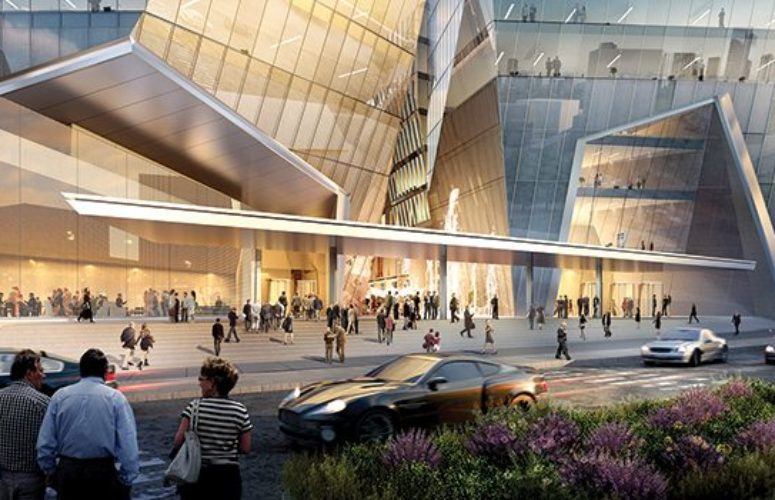
Bullish on the Big Cities
Cities attract residents and have notable economic development projects.
By Colleen O’Dea, Contributing Writer On Jun 29, 2015As many reports have shown, people and business have shifted their interests from the suburbs to the cities, and New Jersey’s major cities can attest to that, parlaying major roads and mass transit, higher education facilities, Urban Enterprise Zones and state tax incentives into booming economic development.
Newark
New Jersey’s largest city is in the midst of significant redevelopment. Newark’s population has grown to more than 278,000. According to the US Census Bureau, it posted the fourth largest population gain in New Jersey between 2012 and 2013.
It’s easy to see why. Several of the state’s busiest highways run through the city, including both the Turnpike and the Garden State Parkway, Interstates 78 and 280, and Routes 9 and 21. Newark’s Penn Station is a hub for NJ Transit, Amtrak and PATH rail service. The city also houses New Jersey’s major airport, Newark Liberty International. And, the Port of New York and New Jersey, which includes Port Newark, is the second busiest in the nation.
Newark is also home to some 55,000 students attending Rutgers University’s Newark campuses, New Jersey Institute of Technology and Essex County Community College. It also has two major entertainment venues: the New Jersey Performing Arts Center and the Prudential Center.
All of this, plus tax incentives from the state and the city, have led to a construction boom, with $2 billion in development in the pipeline right now, says Baye Adofo-Wilson, deputy mayor for economic and housing development.
The city is home to two Fortune 100 companies. Panasonic moved to a 340,000-square foot facility in September 2013, bringing an estimated 200 new jobs. Meanwhile, Prudential Financial is in the process of finishing a 740,000-square-foot, 20-story office tower on Broad Street across from Military Park.
The Prudential construction boosted plans to redevelop the former Hahne’s store, which fronts Military Park and closed in 1986. In 2013, Hanini Group of Newark bought the building in partnership with L+M Development and is repurposing its 440,000 square feet.
Rutgers University has agreed to lease three floors of the building for studio, classroom and gallery space and is partnering with a number of community organizations, including the Newark Museum, NJPAC and WBGO on the project it is calling Express Newark. The university has committed to spend as much as $25 million, including $8 million in incentives.
“We aspire for Express Newark to play a pivotal role as a ‘third space,’ where the university and community come together to advance scholarship, strengthen our community, and build the momentum behind Newark’s renaissance,” said RU-N Chancellor Nancy Cantor in announcing the project.
The school is involved in another redevelopment project – at its former Law School Building, originally the American Insurance Co., at 15 Washington St.
The 17-story neo-classical building is being converted as part of a public-private partnership with the New Brunswick Development Corporation into a combination of undergraduate and graduate housing, as well as academic, student and administrative space. It will also become Cantor’s home. The $85-million cost is being financed in part with about $11 million from the New Jersey Higher Education Facilities Trust Fund and $13 million in tax credits from the New Jersey Economic Development Authority.
There’s more development in the area, as well.
Dranoff Properties is partnering with NJPAC for One Theater Square. The curved, 22-story glass tower on 1.2 acres across the street from NJPAC and across Military Park from Prudential will have 242 apartments, 15,000 square feet of retail and parking.
And next to NJPAC, Boraie Development is building the first residential high rise in Newark since 1960. The $65-million, 23-story tower will include 169 market-price units and 8,500 square feet of retail space. Work should start this summer.
However, a vibrant downtown is not enough to revitalize a city, so Newark has also put in place the Model Neighborhood Initiative, which Adofo-Wilson says is targeting “some of our poorest neighborhoods” for improvement. The city is working to both better the business districts along Bergen Street, Springfield Avenue, South Orange Avenue and other similar thoroughfares and the surrounding residential areas.
Jersey City
With more than 257,000 residents as of mid-2013, Jersey City is creeping closer in size to the state’s most populous city. A booming part of New Jersey’s Gold Coast, Jersey City added about 10,000 residents, or nearly 4 percent, since 2010, according to data from the US Census Bureau.
Access is one of Jersey City’s attractions. Not only do major roads – the NJ Turnpike and Routes 1 and 9 – lead there, but so does the Holland Tunnel, New York Harbor ferries and PATH trains.
The city is also home to Hudson County Community College and two universities – St. Peter’s University and New Jersey City University – both of which have done their share to drive economic expansion in recent years.
In May, NJCU broke ground on a $400-million 425-bed Student Residence Hall. Scheduled to open in September 2016, the building will more than double the amount of housing available. It is being constructed as part of a public-private partnership with Ambling University Development Group and the university and the NJCU Foundation.
“This student residence hall is a core component of both the development of NJCU’s West Campus and the revitalization of Jersey City’s west side,” said Sue Henderson, president of the university, when announcing the project.
St. Peter’s University has been busy growing for the last four years. In 2013, it opened the 6-story, 90,000-square foot MacMahon Student Center, a $49-million project begun in 2011. Last year, it completed significant upgrades to its business and education school facilities.
The college also has plans for a $210-million 20-story residential tower in McGinley Square. A joint venture with Sora Development of Towson, Maryland, the tower is to be built on a university parking lot and include both student housing and apartments, a parking garage, bank, movie theater, restaurants and other retail space.
The development at St. Peter’s is meant to complement the city’s efforts to revitalize the McGinley Square area.
“This is a great day for Jersey City,” says Mayor Steven Fulop. “The McGinley Square-Montgomery Gardens neighborhood has many tremendous assets, including easy public transit, varied housing stock and community assets, as well as vibrant and diverse surroundings.”
In conjunction with The Michaels Organization of Marlton, the city’s housing authority has developed a $580-million revitalization plan that calls for 434 new affordable rental units, out of a total 887 units, as well as a preschool and Early Childhood Education Center, a new K-12 METS Charter School, a full-service supermarket, a health clinic and new retail and office space.
Nineteen city projects have been approved for $516 million in tax incentives since the end of 2013 under the Grow NJ program from the New Jersey Economic Development Authority. These represent 2.6 million square feet of space, creating 3,974 new jobs and retaining 4,459 jobs at risk of being lost, according to EDA data.
The largest of these projects is a $225-million award to JP Morgan Chase to stay in the city, purchase the downtown building it had been leasing and complete $77 million in renovations. As part of that, the financial giant pledged to add 1,000 employees to its workforce of 2,612.
There’s a major project going up at Journal Square, as well. Construction has begun on Journal Squared, a 2.3-million-square-foot project near the PATH terminal in roughly the center of the city. It is to include retail, restaurants, parking and 1,840 residential units in towers, one of which is to be the highest residential building in New Jersey, at 70 stories tall. The first tower, 54 stories, broke ground in January 2014 and is expected to be completed by mid-2016. Kushner Real Estate Group and National Real Estate Advisors are building the project, designed by Hollwich Kushner and Handel Architects. The total cost is estimated at around $660 million.
Four new hotels are also in various stages of development. There is a 13-story Hyatt House being built at 1 Exchange Place. Also downtown, a 152-room Marriott is being built at the Grove Street PATH station. Construction is beginning on a third downtown hotel, a five-story inn near the Holland Tunnel. And a 75-room hotel is planned across town, at Tonnele Avenue and Secaucus Road.
Elizabeth
The fourth largest municipality in New Jersey, Elizabeth has developed a comprehensive economic development strategy, which outlines the attraction, retention and expansion of businesses.
Elizabeth’s population has risen this decade to nearly 128,000, but the city accommodates many more people on weekdays, including students attending Union County College and other schools and those working in the seat of Union County. The city is also home to one of the state’s largest malls. Building on its unique geographic advantages, the city claims a portion of Newark Liberty International Airport and the Port Elizabeth-Newark International Container Seaport, is crossed by the New Jersey Turnpike and Routes 1&9 and is home to NJ Transit rail and bus hubs.
“The city continues to take an aggressive approach to improving the quality of life within Elizabeth through the application of nearly $25 million in federal stimulus funds,” says Mayor Christian Bollwage. “Continuing to sustain the local economy, these improvements and programs include energy initiatives, new infrastructure, housing, police officers and public safety equipment.”
Among those developments is a $55-million upgrade to the Historic Elizabeth Midtown Train Station, a vibrant location within the heart of a redevelopment area and within walking distance of Union County offices, city hall, the library and UCC. It is slated to be completed in 2018.
“From improving and strengthening transportation services to supporting development efforts and population growth, this project will transform the Midtown Station into a state-of-the-art rail destination,” Bollwage says.
The area has received one of 27 Transit Village designations in the state and Elizabeth has contracted with Faros Properties and MAS Development to develop two parcels near the station. At an estimated cost of more than $125 million, the village is to include about 425 market-rate and 125 affordable residential units with parking, 35,000 square feet of commercial space and a 9-story hotel with 135 rooms and 18,000 square feet of meeting space. It will also feature open space, including the continuation of the Elizabeth River Trail. The site is expected to create 135 permanent jobs. Groundbreaking is expected this summer.
Next to the city’s other station, the North Elizabeth station, a multifamily building is nearing completion on Pennsylvania Avenue. The $20-million project created more than 80 construction jobs.
Elizabeth’s premier shopping location will be growing soon. Simon Property Group announced in May its plans to increase Jersey Gardens by one third, adding 411,000 square feet to its 1.3-million-square-foot footprint. One of the state’s largest malls, The Mills at Jersey Gardens, already has more than 200 stores. Simon expects to begin construction next year and open the new section in 2018.
The city welcomed several new facilities last year. On Broad Street, not far from the redevelopment area, Trinitas Regional Medical Center opened a $5.2-million, 9,500-square-foot ambulatory surgery center. Wakefern Food Corporation opened a new 524,000-square foot warehouse, bringing an estimated 150 new jobs to the city. And Embassy Suites Hotel opened an 82-room hotel with an 87,200-square-foot restaurant near Jersey Gardens.
The city is working with East Grand Division LLC and Majic Elizabeth I LLC on the redevelopment of the former NJ Transit Bus Garage Property at East Grand and Division streets for a $25-million supermarket-anchored shopping center. Plans include a 25,000-square-foot grocery store with additional retail and fast food space, expected to create 150 jobs.
Elberon Development is planning to start work on an industrial warehouse project off of Route 1&9 and Fairmount Avenue with 300,000 square feet of space.
The Durant Street Redevelopment, also known as Baker Center or Burry Biscuit, is a privately owned site poised for a three-phase development project that would include two big box tenants, a retail strip mall and 150 residential units. The $135-million project is estimated to take 10 years to complete and create 500 jobs. It would be located just blocks from the North Elizabeth station.
Camden
While the city has struggled for decades, Camden is in the midst of a renaissance. With a population of almost 77,000, Camden is well positioned for growth due to its proximity across the Delaware River from Philadelphia and easy highway access – Interstates 76 and 676 and Routes 30 and 130 all run through at least a portion of the city. It is also easily accessible from all directions via mass transit, as both PATCO and NJ Transit River Line run through the city. Rutgers Camden, which includes a law school, and Cooper University Hospital are major employers and economic drivers.
The biggest boost to the city is coming from Holtec International, which is building a $260-million, 600,000-square foot manufacturing and design center on 47 acres along the southern waterfront. Helped by a $260-million Grow NJ tax incentive, it is the largest single private economic investment in the city’s history. The Holtec Technology Center will manufacture components for the company’s patented spent fuel storage technology and test its small modular nuclear reactor technology. It projects an initial 395 jobs, growing to an eventual 2,000 craft laborers and 1,000 professional workers. Operations are to begin in mid-2018.
In a letter to the Philadelphia Inquirer last April, Holtec president and CEO Krishna P. Singh said the facility will “make the Philadelphia-South Jersey region the intellectual and manufacturing capital of a transformative technology, with more than $1 trillion in long-term business prospects.”
Subaru of America is moving its corporate headquarters to Camden, planning a 320,000-square-foot facility next to Campbell’s Soup Company. The $118-million facility, supported by Grow NJ tax incentives, is to employ 600 workers – 100 of them new jobs – and open in 2016 or 2017. The move expands and consolidates several smaller offices in South Jersey.
Lockheed Martin is also moving to Camden, bringing 250 jobs to a 51,000-square foot facility. The defense contractor is getting $107 million in Grow NJ tax incentives for its $146 million investment.
And another high profile Grow NJ project is giving $82 million to the Philadelphia 76ers to build a 120,000-square foot practice facility and campus across the river from the team’s home base. The team estimates it will create 250 new jobs.
New Brunswick
Rutgers University has always been a dominant presence in New Brunswick, and today it is one of the engines driving economic development in this small, growing Central Jersey city. New Brunswick had the third largest population increase of New Jersey municipalities, up about 2 percent to nearly 56,000 in 2013, and that doesn’t include some 7,000 students living on the Rutgers campus.
The city is easily accessible via the Turnpike and Routes 1, 18 and 27. It also has a NJ Transit rail station that is the center of a transit-oriented development.
The Hub @ New Brunswick Station is a four-acre redevelopment site across from the station. It will include about 1.5 million square feet of mixed-use space in two towers. There will be about 500 units of housing to rent or own, office and research space, and 100,000 square feet of retail. Demolition to clear the site is expected to start this summer.
“This is a pretty significant project,” says Christopher Paladino, president of New Brunswick Development Corp., or DEVCO, which is developing the project.
The Hub is the third phase of the Transit Village Initiative. The first was the mixed-use Gateway building a block away from the station. Completed in 2012, Gateway is a $143-million, 632,000-square-foot, mixed-use development that includes apartments and luxury condominiums, a 45,000-square-foot Barnes & Noble University Bookstore, more retail space, office space for Rutgers and the New Brunswick Parking Authority and parking. The second phase was the $105-million, 600,000-square-foot Wellness Plaza, also finished in 2012, up the street from where The Hub will be built. It includes retail space, parking and a fitness center.
DEVCO is also developing the $330-million College Avenue Redevelopment project in partnership with Rutgers. Covering about 860,000-square feet of space, the redevelopment includes the first new academic building to be built on Rutgers’ College Avenue Campus in 55 years, a new 500-bed residential Honors College expected to open in the fall and a 500-bed student apartment complex, as well as ground floor retail and a 25,000-square-foot public green space that will include a boardwalk and a large outdoor video display for viewing cultural and sporting events, news and original programming. It also includes a new 30,000-square-foot academic and administration building for the New Brunswick Theological Seminary and a new facility for Rutgers Hillel.
The work is being financed in part with $33 million in NJ Urban Transit Hub Tax Credits and $55 million from the State Higher Education Facilities Trust Fund.
“Across the country, a lot of economic development in smaller cities is based on public-private partnership with universities,” Paladino says. “Since Rutgers totally integrated the Robert Wood Johnson Medical School, the administration has become far more entrepreneurial … Rutgers is an active partner with us,” Paladino says.
The university is one reason why companies are interested in New Brunswick, he continues. Businesses say they hire a lot of Rutgers graduates, so it makes sense to be nearby and establish relationships with the school and student – its future workers.
Millennials and empty nesters enjoy living in a walkable college town with mass transit, restaurants and nightlife, which also makes New Brunswick a draw for employers and those moving into the new residential units.
Related Articles:






